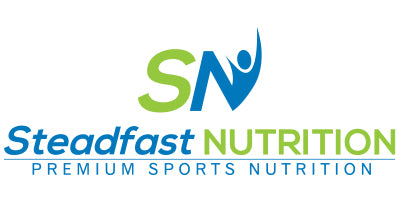Back exercises are a set of exercises that target every muscle group of the back. The back covers the major posterior part of the human body that has multiple functions - providing structural support to the spine, maintaining posture, movements of joints, stabilisation of the core, etc. Back exercises should be focused on strengthening the muscles and core, improving posture, attaining a V-shape physique, increasing flexibility, and preventing back pain. Back exercises should include bodyweight exercises, strength training, yoga, and stretching. Back exercises that can target overall back muscles include pull-ups, lat pulls, deadlifts, rowing, cat-cow stretches, and cobra poses.
Back workouts we should target
The back muscle is located just below the skull, extending across the shoulder blades and down to the lower back. Back muscle can be categorised based on tissue location. The back muscle covers the major back portion, so it can be divided into 3 parts - upper, mid and lower back.
Based on tissue location:
Superficial Muscles:
These are the muscles near the surface of your back. They help with shoulder movements. The main ones are:
- Trapezius: A big muscle that helps move your shoulder blades up and down. You can work on it with exercises like farmer's walks and shrugs.
- Latissimus dorsi: It's in your lower back and helps with moving your arms. Exercises like pull-ups and rows are good for this muscle.
- Levator scapulae: A small muscle that starts in your neck and goes to your shoulder blade. Rowing and shrugs are good for this one.
- Rhomboids: These muscles help pull your shoulder blades back. Exercises like shoulder rotation, rear delt fly, and cable rows target them.
Intermediate Muscles:
These are deeper than the superficial ones. They include:
- Serratus posterior superior: A thin muscle under the upper back muscles. It helps lift your rib cage.
- Serratus posterior inferior: It's below your latissimus dorsi and helps lower your rib cage.
Deep Muscles:
These are even deeper layers of muscles:
- Superficial deep muscles: These are associated with head and neck movements. You can stretch them by flexing your neck.
- Intermediate deep muscles: They form a column called the erector spinae and help flex your spine. Exercises like deadlifts and hyperextensions work these muscles.
- Deep deep muscles: These are short muscles involved in head rotation and spine flexion. Exercises like neck stretches and bird dogs target them.
The Warm-Up
Warm-ups should be performed before starting any exercise to prepare the body for physical activity and increase blood circulation to avoid the risk of injury. Warm-up consists of light physical activity, mobility exercises, and dynamic lower back stretching.
Benefits:
1. Increases blood flow:
Warm-up prepares the body for exercise by increasing blood flow to the tissues and muscles.
2. Increase in body temperature:
Increased blood flow slightly increases the body’s core temperature.3. Increases oxygen requirements:
Oxygen supplies increase because the heart works more efficiently to ensure smooth blood flow.
4. Reduces chances of injury:
Increased blood flow increases blood circulation in the body, thereby increasing aerobic capacity, improving muscle coordination, increasing muscle efficiency, and thus reducing the chances of injury.
5. Increases range of motion:
Warm-up increases mobility and flexibility of the muscles, increasing the muscle efficiency to contract smoothly, increasing the range of motion.
Best Warm-Up Exercises for Back Muscles:
- Foam roller back extension
- Toe touch
- Cat cow stretch
- Spiderman stretch with rotation
- Bird dog
- Hyperextension
- Supine twist back stretch
- Pull-ups / assisted pull-ups
- Bridge pose
Best Back Building Programs
1. Include more compound movements:
Compound exercises such as pull-ups, deadlifts, barbell rows, and pull-downs should be done at the beginning of the workout, then progressing towards isolation exercises at the end of the workout.
2. Weak point training:
Body parts that are weak compared to other parts should be trained more frequently and at the beginning of the back workouts.
3. Outer back development:
Rows when done with a narrow grip develop the outer back because a narrow grip shortens the range of motion and puts emphasis on the outer back muscles.
4. Upper back development:
To develop the upper back, back exercises such as bent-over barbell rows, seated wide grip rows, and narrow grip pull-downs should be included in a workout routine.
5. Lat width:
Latissimus dorsi is an extremely important muscle, especially in bodybuilding. The sweep and width of the latissimus dorsi are enhanced by doing exercises that pull it out to the side. Back exercises are wide grip pull-ups and wide grip pull-downs.
6. Lower latissimus dorsi development:
The sweep of the lats becomes less effective if it doesn’t extend down to the waistline. Exercises to help train lower lats are one-arm cable rows and close-grip pull-ups.
7. Middle back thickness:
The greatest amount of work is done by the middle back when the range of motion is extended as far as possible. Eg, wide grip cable rows.
8. Overall back development:
Back exercises such as pull-ups, pull-downs, deadlifts, and rows along with shrugs and rear delt fly should be included in the routine for overall back development.
9. Stretching and flexing:
Stretching the lats helps achieve the long sweep of the muscle. It lengthens the muscle, increases the range of motion, and deepens contractions. Flexing can be done in between the workout sets or at the end of the exercise for increased contractions.
10. Progressive overload:
Progressive overload helps increase muscle efficiency, strength, and size of the muscle. To develop a strong back, weight should be increased gradually to recruit more muscle fibres in the muscle tissues.
Benefits of Back Training
1. Improved posture:
Prolonged sitting causes hunched back and rounded shoulders. This leads to poor posture and weakened back muscles. Back exercises such as seated chest stretch, child’s pose, and cat-cow stretch help in relaxing and retracting the shoulder. Gradually it will help in fixing the poor posture.
2. Prevent back pain:
A sedentary lifestyle, poor sitting posture, and being overweight puts a lot of strain on the back muscles, causing them to weaken. Regular back exercises help strengthen the back, preventing or managing back pain.
3. Stable spine:
The spine is a vital part of the body, essential for maintaining various body processes. It provides structural support and helps to maintain the body in a stable position. Regular back workouts help in maintaining spine health and fixing spine position.
4. Strong back muscles:
The back is a major upper body muscle that is responsible for serving various bodily processes such as spine stabilisation, providing support to structure, movement, carrying heavy items, etc. Thus, back exercises will help strengthen the back muscles.
5. Breathe:
Back muscles help in the contraction and relaxation of the rib cage. Enhanced movement of the rib cage will help in improving breathing and respiration.
6. Improved flexibility:
Regular back stretching and mobility exercises improve the flexibility of the spine and back muscles. Increased flexibility allows muscles to move smoothly without causing pain. Back exercises such as the plank, cat-cow stretch, downward dog stretch, glute bridge, and child’s pose are great options that can increase back flexibility.
7. Reduces injury:
Increased range of motion allows greater movement of muscles without causing pain or injury. Hence, back exercises reduce the chances of injury.
8. Increased blood circulation:
Back exercises such as stretching increase blood flow through the body, helping in the removal of toxins and lactic acid accumulated in the body.
9. Achieving a V-shape physique:
V-shape physique development is very important, especially in bodybuilding - a broad V-shape makes the waist look smaller, enhances the physical appearance and looks aesthetic. To develop a V-shape, both sides of the latissimus dorsi should be trained equally. Back exercises such as wide grip lat pulldowns, wide grip pull-ups, and wide grip rows help in developing a V-shape.
10. Build lean muscle mass:
Back exercises help in toning and tightening the upper back and in losing back fat.
How to Loosen a Tight Back?
1. Stretching:
Regular back stretching and mobility exercises improve the flexibility of the spine and back muscles. Increased flexibility allows muscles to move smoothly without causing pain. Back exercises such as the plank, cat-cow stretch, downward dog stretch, glute bridge, and child’s pose are great options that can increase back flexibility.
2. Warm-up and cool down:
Warm-up stretching before starting exercise increases blood circulation in the body and helps in loosening the back muscles. In addition to it, cool down should be done at the end of the exercise, it helps in relaxing the muscle tissues.
3. Proper sitting posture:
The back muscle is responsible for flexing and extending the hip, including the leg muscle. Poor sitting posture for a prolonged period leads to stiffness and pain in the lower back. The spine position should be straight during sitting and shouldn’t be seated at a stretch.
4. Relieve stress:
Stress decreases blood circulation and increases tightness in the back muscles. Regular stretching helps reduce stress, loosening the tight back muscles.
5. Core strengthening:
Loss of core strength decreases stability in the lower back. To help protect the spine, the body compensates for muscle loss by tightening the back. Thus, core strengthening exercises should be included in the exercise routine.
How Can I Shape My Back Fast?
1. Cover every muscle group
A back exercise should cover all the muscle groups located in different positions. Either every muscle group can be trained in one day or can be divided into a two-day schedule. For instance, latissimus dorsi, trapezius, and rhomboids can be trained one day a week. The mid-back and lower back can be trained on another day.
2. Loose body fat
Training cardio such as cycling, HIIT, running/walking, and elliptical help increase endurance and rapidly depletes stored glycogen and thus helps in losing overall body fat.
3. Maintenance or calorie deficit
To gain muscle mass and lose body fat from the back, calorie intake should be equal to or less than BMR. Calorie surplus will cause the gaining of fat around the back and thus it won't give the desired result.
4. Compound exercises
To rapidly increase strength in the body, compound exercises should be done at the beginning of the workout. This will help in increasing the muscle size and attaining the V shape of the back muscle.
5. Training twice in a week
Depending upon recovery time, back exercises can be done twice a week and it will give shape to back muscles.
20 best back exercises to build muscle
1. Wide grip pull-ups behind the neck
It is a bodyweight exercise that targets the upper body. To perform this, hold the bar with a wide overhand grip. From the hanging position, try to pull up the body towards the back of the neck till it touches there.

2. Wide grip pull-ups to the front
It is the alternative to the pull-up behind the neck. To perform this, hold the bar with the hands as wide as possible. Then hang from the bar and pull the body up as if the bar is touching the chest.
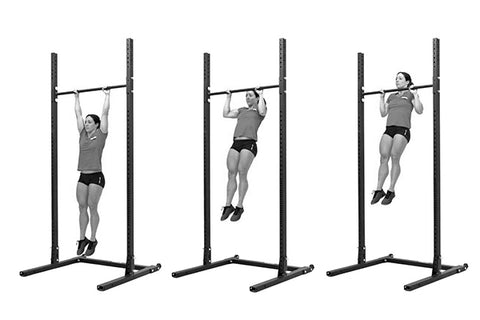
3. Close grip pull-ups
This exercise develops the serratus and lower latissimus. To do this, hold the bar with a close grip and then pull up the body so that the chest touches the bar.
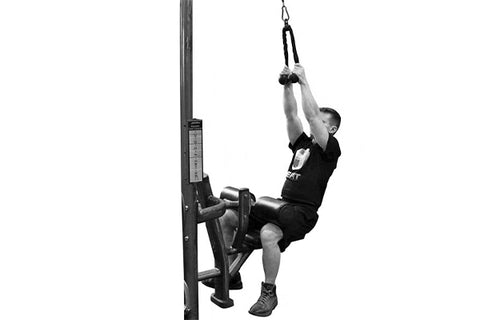
4. Lat pull down
This exercise allows the expansion of the upper latissimus. To do this, hold the bar with a wide overhand grip and then pull down the bar till it touches the top of the chest.

5. Close grip pull down
This exercise focuses on building the lower latissimus. To do this, hold the bar with a close grip and then pull down the bar till it touches the top of the chest.
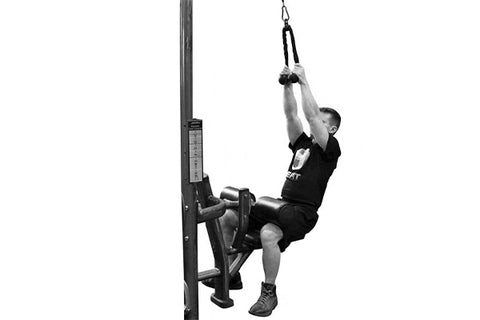
6. Bent over barbell rows
The purpose of this exercise is to thicken and widen up the upper back. To perform this, stand with slightly wide feet holding a barbell with an overhand grip. The body should be slightly bent forward keeping the back straight and the knee slightly bent. Pull the barbell close to the upper thighs focusing more on engaging the back muscles. Lower the barbell to the starting position.

7. Bent over dumbbell rows
The movement is the same as that with barbell rows. It isolates each side of the upper back. Two dumbbells are used in place of the barbell and throughout the motion the back should be kept straight.
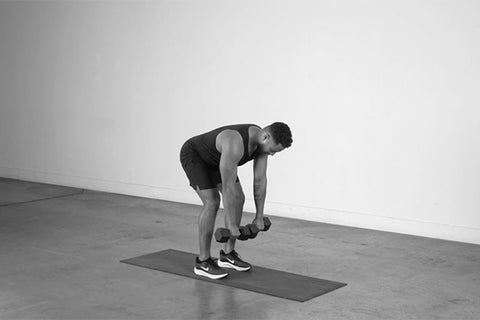
8. T-bar rows
This exercise focuses on thickening the mid back. To do this, stand with closed feet, knees slightly bent and grasp the T-bar machine with a neutral grip. Pull up the bar till it touches the chest.

9. One arm dumbbell rows
It is an isolation exercise engaging the latissimus of each side. To do this, hold a dumbbell in one hand and bend forward until the upper body is parallel to the floor. Place the other hand on the bench for support and then lift the dumbbell towards the side. After finishing 10-12 reps, perform with the other arm.
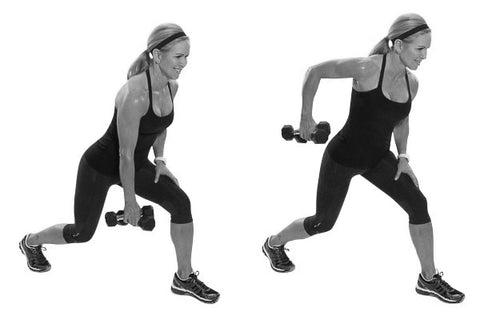
10. One arm cable rows
This exercise focuses on developing the lower latissimus. To do this, in a seated position hold the handle of the cable with one hand and then pull the cable towards the side of the back muscle. After that, return to the starting position.

11. Seated cable rows
This exercise helps in developing the overall thickness of the back and lower lats. To do this, sit on a cable machine, grab the handle and place the foot against the crossbar with knees slightly bent. Pull the handle towards the body till it touches the abdomen.
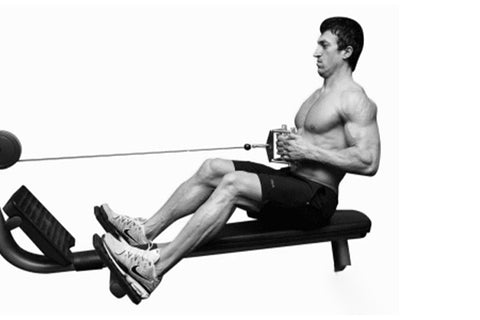
12. Pullover
This exercise works on the lower lats and serratus muscles. Pullover can be performed either by barbell/dumbbell/ machine. It is performed by lying down on a bench holding the dumbbell/barbell in an overhand position and then pulling the object over the head.

13. Deadlifts
It is a power-packed exercise that targets several muscles with the knees bent.
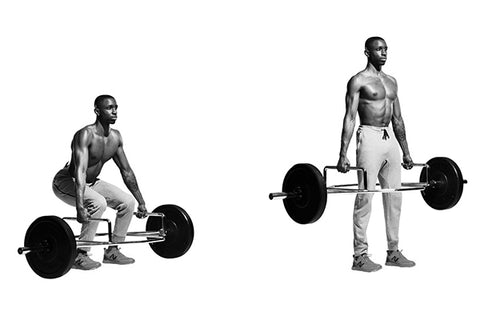
14. Good morning
This is an isolation back exercise focusing mainly on the lower back. To perform this, stand a few inches apart, and hold a barbell on the back of the shoulder. Keep the legs locked and back straight, and bend forward from the waist until the abdomen is parallel to the floor. Return to the starting position.
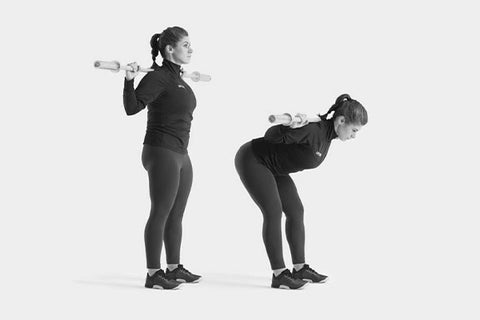
15. Hyperextension
This exercise can be done on a hyperextension machine or a bench. Position yourself with a face down and then bend downward as low as possible.
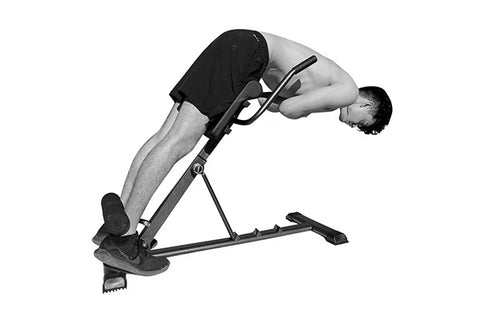
16. Inverted row
It is suitable for those who struggle to do pull-ups. To perform this, set up a bar at waist height. Grab the bar with an overhand grip and hang below the bar. Then pull up the body till the chest touches the bar.

17. Renegade row
It increases the strength of the upper body. To do this, start yourself in a push-up position and grab two dumbbells in both hands. Keeping the core engaged, lift the right hand close to the abdominals and then return to the starting position. Repeat this movement with the other hand.
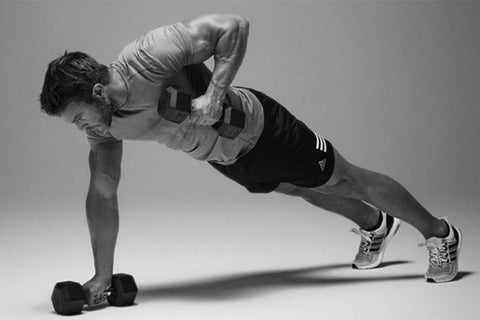
18. Shrugs
It mainly targets the trapezius muscle of the upper back. It can be done either with a barbell or a dumbbell. Grab the handle of the barbell/dumbbell lift the weight using only the shoulder and then return to the starting position.

19. Straight arm cable pull-down
This works on the lower lats of the back. To do this, grab the handle of the cable with arms straight pull it towards the upper thigh and then return to the starting position.

20. Superman
It is a back stretching exercise and doesn’t need any special machine to perform. To do this, lie down on the floor in a prone position and then raise your hands and legs off from the floor and then return to the starting position.
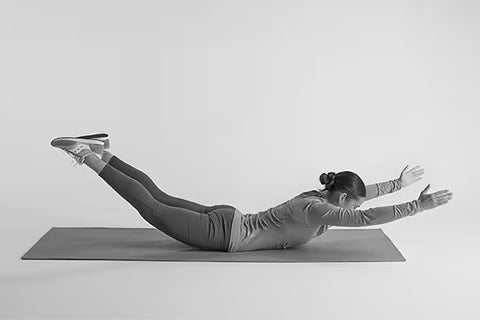
Top 10 Heavy Back Workouts for Men
- Lat pull down
- Pull-ups
- Close grip pull-down
- T-bar rows
- Pullovers
- Bent over rows
- Dumbbell rowing
- Deadlift
- Shrugs
- Seated row
Best bodyweight exercises to build a bigger back
1. Superman
This exercise focuses on engaging the upper and lower back muscles. It is a back stretching exercise and doesn’t need any special machine to perform. To do this, lie down on the floor in a prone position and then raise your hands and legs off from the floor and then return to the starting position.

2. Pull-ups
It is one of the best bodyweight exercises that target every upper back muscle. It can be performed with either a close or wide overhand grip. To do this, hold the bar with a close grip and then pull up the body so that the chest touches the bar.
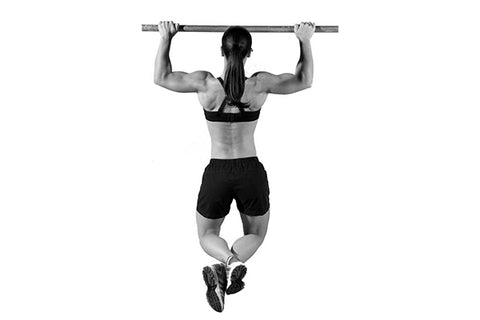
3. Inverted row
Pull-up can be a bit challenging for those who don’t have enough upper body strength. The inverted row also works on the same muscle group. To perform this, set up a bar at waist height. Grab the bar with an overhand grip and hang below the bar. Then pull up the body till the chest touches the bar.

4. Prone pull-up
To perform this, get into a Superman position and then raise your arms. From there perform the same pull-up movement till the arms form a ‘W’ shape.

5. Dead stop
To perform this, start in a push-up position and then at the top of the movement squeeze the back muscle. Then bring back the arm to the starting position.
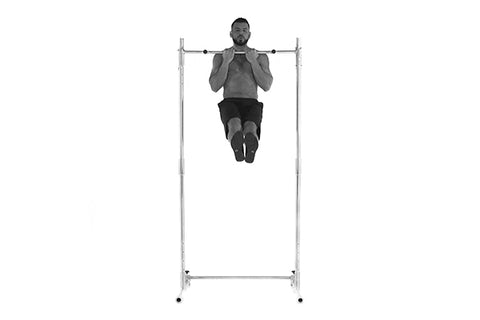
6. TRX row
The movement is the same as that of the inverted row. Here, instead of a barbell, the TRX band is used to lift yourself from the floor and at the top of the movement squeeze the back muscle. After that, straighten out the arm and return to the starting position.
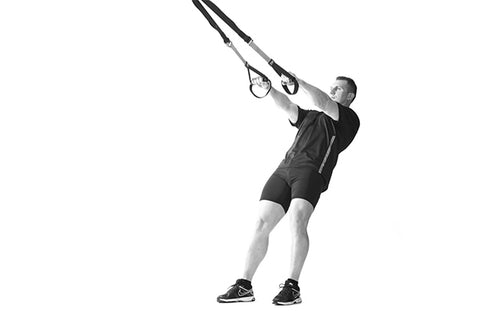
7. Hyperextension
This exercise can be done on a hyperextension machine or a bench. Position yourself with a face down and then bend downward as low as possible.

8. Bird dog
This exercise targets multiple muscle groups including the back, glutes, shoulders and core. To perform this, start with a four-legged position. Engage the core muscles and extend the left arm and right leg simultaneously till it is parallel to the floor. Repeat this on the other side.
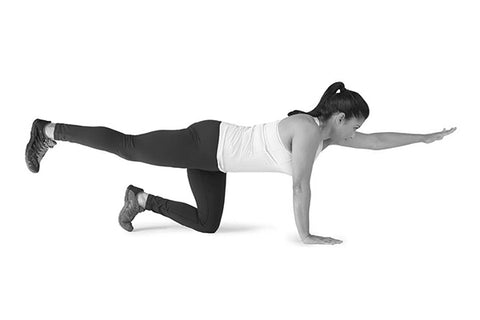
9. Cobra pose
To perform this, lie down on a surface and place the hands beside the ribs. Then lift the upper body by straightening the arm. Return to the starting position.
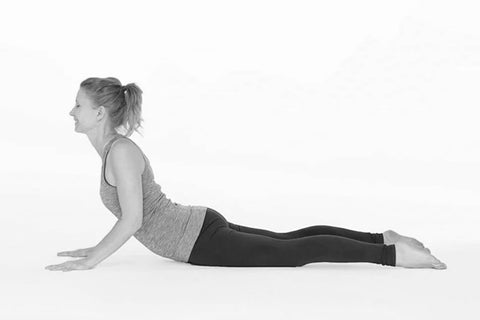
10. Cat cow stretch
It is a dynamic stretching exercise that improves the flexibility of the back muscle. To do this, start with a four-legged position. Slowly inhale and pull your chest and chin from the floor and then slowly exhale and push the chest towards the floor.
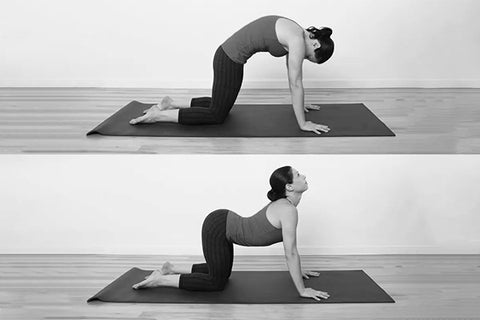
5 Best Back Exercises to Build a V-shape
- Pull-ups
- Deadlift
- Barbell rows
- Lat pulldown
- T-bar rows
A simple back workout routine can be:
- Inverted row/pull-ups - 3 sets of 12 reps each
- Lat pull down - 3 sets of 12 reps each
- Bent over rows - 3 sets of 12 reps each
- Deadlifts - 3 sets of 12 reps each
- Hyperextension - 3 sets of 12 reps each
- Shrugs - 3 sets of 12 reps each
The back muscle covers the major posterior part of the human body and acts as a supportive structure for the spine. Therefore, to maintain spine health, and improve poor posture and other functioning, back exercises should be included in the exercise routine.
